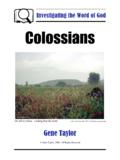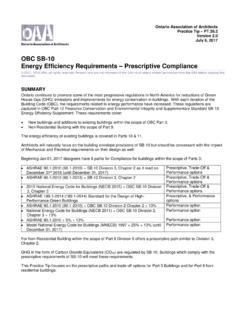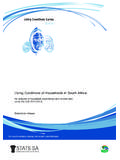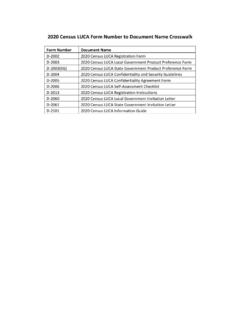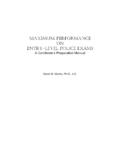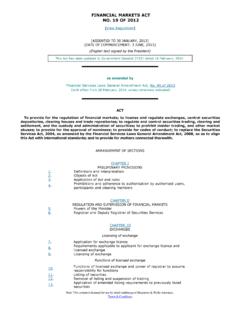Transcription of Determining current health and safety practices, …
1 health and safety executive Determining current health and safety practices, awareness of HSE initiatives and economic trends in relation to isocyanate paint use in the motor vehicle repair sector Prepared by the Institute for Employment Studies for the health and safety executive 2010. RR802. Research Report health and safety executive Determining current health and safety practices, awareness of HSE initiatives and economic trends in relation to isocyanate paint use in the motor vehicle repair sector Andrea Broughton Frederique Sumption Nick Jagger Claire Tyers Sovereign house Church Street Brighton BN1 1UJ. This report contains the main results of research carried out for the health and safety executive (HSE), by the Institute for Employment Studies examining health and safety practices and procedures in relation to the use of isocyanate-based paints in the motor vehicle repair (MVR) sector.
2 The main objective of this research was to determine current health and safety practices in the motor vehicle repair sector in relation to the use of isocyanate paint spray, focusing in particular on the use of masks and the use of spray booths. The intention was to gather data about practice, in order to gain a view of the overall state of play in relation to the health and safety practices that determine isocyanate use in the sector. The intention was that this will, in turn, make it possible and viable for the HSE to develop a baseline for targeting future embedding activity. The report is based on a telephone survey of 500 motor vehicle repair bodyshops and visits to 30 bodyshops, during which face-to-face interviews were carried out with bodyshop managers and sprayers.
3 This report and the work it describes were funded by the health and safety executive (HSE). Its contents, including any opinions and/or conclusions expressed, are those of the authors alone and do not necessarily reflect HSE policy. HSE Books Crown copyright 2010. First published 2010. All rights reserved. No part of this publication may be reproduced, stored in a retrieval system, or transmitted in any form or by any means (electronic, mechanical, photocopying, recording or otherwise) without the prior written permission of the copyright owner. Applications for reproduction should be made in writing to: Licensing Division, Her Majesty's Stationery Office, St Clements house , 2-16 Colegate, Norwich NR3 1BQ. or by e-mail to ACKNOWLEDGEMENTS.
4 IES has been helped and guided in this work by a range of individuals within the HSE and in particular, Pauline Stenhouse, Louise Rice, Anthony Burke, Mark Piney and Andrew Lake. Thanks go to staff at Ipsos Mori for helping IES in the formulation of the telephone survey questionnaire and for conducting the telephone survey itself. Special thanks are owed to the technical experts Peter Barlow, Ian Holmes and Dr Albert Rooms, who have provided invaluable help and assistance in formulating questionnaires and discussion guides and who carried out the 30 bodyshop visits with enthusiasm and good humour. This project has benefited enormously from their extensive experience and expertise. In addition to the listed authors for this report, a number of IES staff provided important inputs to the project, including Jenny Savage, who conducted stakeholder interviews and James Walker-Hebborn, who provided valuable support in the production of this report.
5 Special thanks go to Karen Patient, who worked tirelessly to organise the bodyshop visits and who also worked on the charts. The most important thanks, however, go to the 500 bodyshop managers who allowed us to speak to them and the 30 who allowed us access to them and their staff and who shared their experiences and time with the researchers. Without their willingness to commit resources to this research, it would have been impossible for us to gain any insight into the current health and safety practices and procedures in motor vehicle repair bodyshops. ii CONTENTS. executive Summary v 1 Introduction 1. 2 Methodology 2. Desk research 2. Stakeholder interviews 2. Telephone survey 3. The bodyshop visits 6. 3 Characteristics and Trends of the Motor Vehicle Repair Sector and its Workforce 8.
6 The motor vehicle repair (MVR) industry 8. Labour Force Survey data 8. Summary 12. 4 The Risks of Isocyanates 13. The history of isocyanate hazard recognition 13. HSE actions and guidance 14. Chapter summary 18. 5 health and safety Practice 20. Working practices 20. Spray booths, including clearance times, air flow, maintenance 21. Spray guns 27. Paints 27. Personal protective equipment 28. Chapter summary 35. 6 health and safety Procedures 37. health and safety instruction and training 37. Signage in the bodyshop 37. Using the masks and lifting the visors 37. Working hours and the bonus system 41. External influences on behaviour 44. Chapter summary 47. 7 health Surveillance 48. Keeping records 51. Chapter summary 51.
7 8 Perception of Risk 53. Views of managers 53. Views of sprayers 54. Prevalence of health problems and impact of behaviour 55. Chapter summary 56. iii 9 Awareness of HSE Information and Guidance 57. Overall awareness 57. Awareness and use of the website (managers and sprayers) 57. Views on the usefulness of the information and guidance 58. Attendance at SHADs and views on their usefulness 59. Other information sources 60. Views on what the HSE could offer additionally 61. Future trends 62. Chapter summary 63. 10 Conclusions 65. Equipment 65. health and safety procedures 65. health surveillance 66. Perception of risk 66. Use of information, advice and guidance 67. Future trends 67. Main issues for the HSE to consider 67.
8 11 Bibliography 69. Appendix 1: Details of Telephone Survey and Bodyshop Visits Sample 72. Appendix 2: Telephone Survey Questionnaire 74. Appendix 3: Pro-forma and Discussion guides for the Bodyshop Visits 94. iv executive SUMMARY. This report contains the main results of research carried out for the health and safety executive (HSE), by the Institute for Employment Studies examining health and safety practices and procedures in relation to the use of isocyanate-based paints in the motor vehicle repair (MVR) sector. The main objective of this research was to determine current health and safety practices in the motor vehicle repair sector in relation to the use of isocyanate paint spray. The intention was to gather data about practice, in order to gain a view of the overall state of play in relation to the health and safety practices that determine isocyanate use in the sector.
9 The intention was that this will, in turn, make it possible and viable for the HSE to develop a baseline for targeting future embedding activity. The research was carried out between June 2009 and April 2010 and comprised: desk research, to inform the study as a whole interviews with industry stakeholders and questions asked to an HSE Field Operations Directorate staff focus group a telephone survey of 500 bodyshops, and 30 bodyshop visits, carried out by IES researchers and technical experts. health AND safety PRACTICES. The following main points emerge from the research: The majority of the bodyshops in this research had a spray booth, although around one- fifth of those responding to the telephone survey said that they had a spray room.
10 Testing and maintenance of booths was usually carried out by external contractors/advisors on a regular basis, which bodyshops trusted to carry out the necessary checks. There was widespread awareness of booth clearance times among the bodyshop managers visited. There seemed to be lower general awareness of clearance times from the telephone survey responses, but this may be because the bodyshop managers did not have the figures to hand when responding to the survey. Although there was no reported difficulty around respecting the clearance times from the bodyshop visits, this was highlighted as a problem by a significant number of smaller bodyshops in the telephone survey. There was still evidence of lack of knowledge around the dangers of invisible spray mist some sprayers believed that it was safe to enter the booth if they could no longer see the spray mist.










